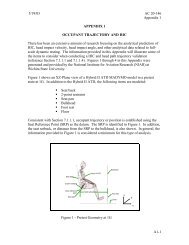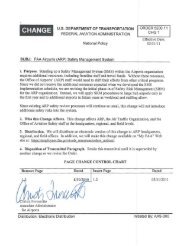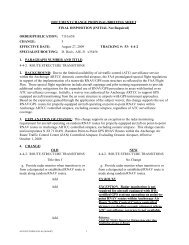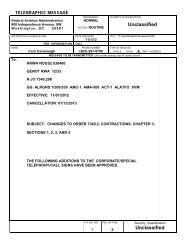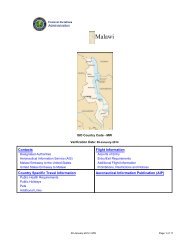2009 SMS Pilot Project (SMSPP) Analysis - FAA
2009 SMS Pilot Project (SMSPP) Analysis - FAA
2009 SMS Pilot Project (SMSPP) Analysis - FAA
Create successful ePaper yourself
Turn your PDF publications into a flip-book with our unique Google optimized e-Paper software.
the applicability of <strong>SMS</strong> per ICAO standards would help maintain a level playing field for U.S.<br />
organizations.<br />
Consideration 2: Scaling <strong>SMS</strong> Rules to Critical Products<br />
An <strong>SMS</strong> rule would be scaled to those certificate and approval holders that design and/or<br />
produce critical products that meet the definition of a hazard, as currently defined in proposed<br />
part 5. This consideration includes scaling the <strong>SMS</strong> rule to the product.<br />
The requirements of the proposed part 5 are scalable. The complexity of <strong>SMS</strong> is determined by<br />
the implementing organization. This may be determined by criteria such as the size of the<br />
organization, location(s) where the work is being performed, complexity and criticality of the<br />
design or production processes, etc. While this approach has flexibility, in that the applicability<br />
is not defined by the type of approval held, this approach could be very cumbersome as it<br />
depends on a definition of hazard that could conceivably go to a part level and require extensive<br />
coordination between multiple organizations (certificate/approval holder, suppliers, etc.) to fully<br />
implement.<br />
So when discussing scalability, can certain aspects of the proposed part 5 rule be considered not<br />
applicable based on the size of the organization and/or the criticality of the product or article<br />
being designed and produced? Elements in the proposed part 5 rule can be seen as not applicable<br />
to certain D&M organizations such as emergency response. When discussing the applicability of<br />
<strong>SMS</strong>, if the <strong>FAA</strong> decides to apply <strong>SMS</strong> to some, but not all, TC, STC, PC, PMA, and TSOA<br />
holders, then there may be graduated requirements.<br />
An implementation process could be based on an <strong>FAA</strong> determination of need. For example, if an<br />
article installed on an aircraft becomes critical based on hazards to that aircraft, then the <strong>FAA</strong><br />
may require the organization to implement a partial or entire <strong>SMS</strong>. It will take additional study<br />
and research to determine which proposed part 5 requirements can be relieved and at what point.<br />
However, if the <strong>FAA</strong> decides to apply <strong>SMS</strong> to certificate and approval holders that create critical<br />
parts or articles failure (meaning that if these parts or articles fail, it could foreseeably cause or<br />
contribute to an aircraft accident, therefore meeting the definition of a hazard), the M<strong>SMS</strong> team<br />
believes that all aspects of a proposed part 5 are applicable. However, this scope excludes any<br />
requirement(s) specifically addressing 121 operations, which would be listed as exclusions in<br />
part 21.<br />
Consideration 3: Applying Rules to All Certificate Holders and Applicants<br />
An <strong>SMS</strong> rule could apply to all certificate and approval holders and applicants. This<br />
consideration includes scaling the <strong>SMS</strong> to the size, complexity, and criticality of the company.<br />
(See Figure 3-4.)<br />
If the <strong>FAA</strong> decides to apply the <strong>SMS</strong> rule to all TC, STC, PC, PMA, and TSOA holders, then<br />
some aspects of proposed part 5 may not be applicable. This will need to be explored in greater<br />
detail to identify which proposed part 5 requirements can be relieved. While this approach is all-<br />
15



